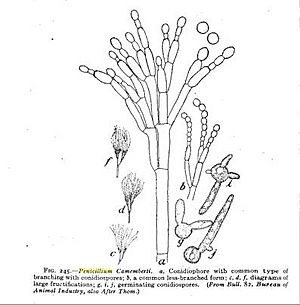Penicillium camemberti facts for kids
Quick facts for kids Penicillium camemberti |
|
|---|---|
 |
|
| Scientific classification | |
| Genus: |
Penicillium
|
| Species: |
camemberti
|
| Synonyms | |
|
|
Penicillium camemberti is a type of fungus. It belongs to the Penicillium family. This fungus is very important for making many popular cheeses. These include Camembert, Brie, Langres, Coulommiers, and Cambozola.
When you see a hard, white crust on these cheeses, that's P. camemberti! It gives these cheeses their special taste and smell. If you are allergic to the antibiotic penicillin, it does not mean you will be allergic to cheeses made with P. camemberti.
When cheese makers create soft cheeses, they can add P. camemberti in different ways. Sometimes, the mold is mixed into the cheese ingredients. Other times, it is added to the outside of the cheese. This happens after the cheese is shaped. P. camemberti helps make Brie and Camembert soft and buttery. But if there is too much, the cheese might taste bitter.
Cheese makers use special methods to check the growth of P. camemberti. This helps them control the cheese-making process. It is important to manage the fungus's growth. This ensures the cheese has the best flavor. It also keeps any natural compounds at a safe level.
Contents
History of Penicillium camemberti
A scientist named Dr. Charles Thom first described this fungus in 1906. Scientists like to study P. camemberti. It grows well in labs. It also creates thick, active mycelia, which are like the roots of a fungus. You can easily find it in cheeses at the store. This fungus is also very important for the cheese industry. It helps make many popular cheeses.
Scientists have studied many types of Penicillium. They found that P. camemberti likely came from a wild type of fungus. This wild type is called P. commune. In 2014, scientists mapped out the full genetic code of P. camemberti.
Natural Compounds in P. camemberti
Like other fungi, P. camemberti can produce natural compounds. One of these is called cyclopiazonic acid. The amount of this compound depends on the specific type of P. camemberti. It also depends on the temperature where the fungus grows. This compound is usually found more on the cheese crust. There is less of it inside the cheese.
For safety, people usually get only a very small amount of this compound from cheese. It is generally considered safe. Still, cheese makers are advised to use types of the fungus that produce less of this compound. This is because the fungus naturally creates it.
Using P. camemberti in Other Foods
P. camemberti gives cheese its main flavor and smell. Because of this, it can also be used to flavor other foods. For example, it is used in dry, fermented sausages. Scientists found that the fungus creates many compounds that give flavor. These include things like ammonia and different types of alcohols.
Scientists have put P. camemberti on the outside of sausages. This helps to make them taste better. The fungus helps break down proteins and fats in the sausage. This process creates new flavors and smells. The fungus forms a protective layer. This layer helps keep the fats inside the sausage fresh. Using P. camemberti can be a good way to start the flavoring process for dry, fermented sausages.
See also
 In Spanish: Penicillium camemberti para niños
In Spanish: Penicillium camemberti para niños

